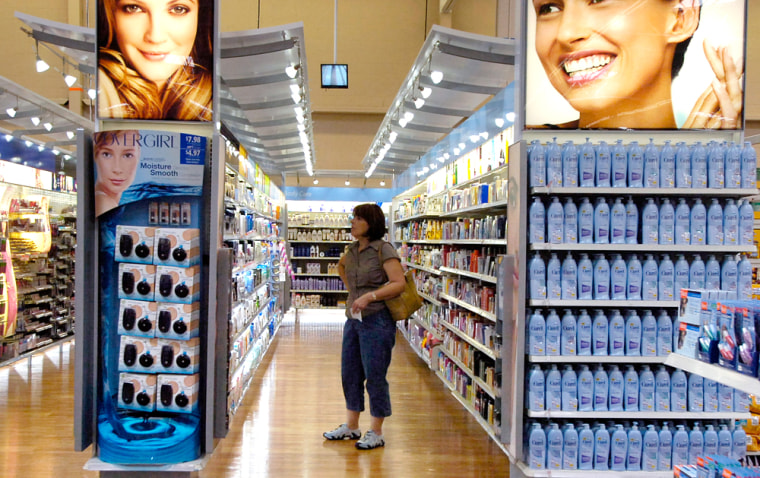Retailers struggling amid a weak economy got a slight reprieve in June, as rebate checks and heavy discounting helped lift sales.
Still, the uptick appeared to benefit discounters such as Wal-Mart most, based on results reported Thursday. The outlook for the back-to-school season remains challenging as consumers continue to grapple with high gas and food prices, among other woes.
Overall retailers reported a better-than-expected gain of 4.3 percent of June, with Wal-Mart Stores accounting for the majority of the uptick in same-store sales, a common measure of chain-store performance.
Wholesale club operators BJ's Wholesale Club Inc. and Costco Wholesale Corp. were also among the best performers. Some rebate money also made its way to clothing stores, like Children's Place Retail Stores Inc., though sales generally remained sluggish at mall-based clothing stores, including Limited Brands Inc. and Gap Inc.
The preliminary tally by UBS-International Council of Shopping Centers beat projections for a 2 to 3 percent gain, according to Michael Niemira, chief economist for the shopping center trade group.
Excluding Wal-Mart's robust gain, the sales tally was up 1.9 percent, though it was slightly better than the 1.1 percent average seen so far this fiscal year, which for retailers began in February.
The results come on top of a better-than-expected 2.9 percent gain in May as the rebate checks began arriving.
Ken Perkins, president of Retail Metrics, a research company in Swampscott, Mass., told The Associated Press the rebate checks provide only a "one-time bump."
"The back-to-school season is going to be challenging," he said.
Nevertheless, the results offered a bit of good news for U.S. retailers who have been feeling the pinch. About two-thirds of U.S. retailers reporting June sales results exceeded Wall Street expectations, according to Retail Metrics. The tracking firm also said the average gain was 4 percent, the biggest monthly increase since March 2007.
Wal-Mart shines
Wal-Mart, whose reputation for bargains has attracted more shoppers as the economy has dampened, said sales at its U.S. stores open at least a year rose 5.8 percent in June, topping analysts' average forecast of 3.8 percent.
The world's largest retailer reported strong gains in grocery, entertainment and health and wellness items and said warmer weather helped sales in such categories as apparel and toys. It also cited strong sales of flat-panel TVs, underscoring the trend of people staying home more.
The discounter raised its earnings outlook, but Chief Financial Officer Tom Schoewe cautioned that "consumers and small business owners remain concerned about the economy, inflation and most of all, higher gas prices."
"With the last large mailing of economic stimulus checks due this Friday, it is difficult to forecast the benefit from the economic stimulus through the remainder of the year," he said in a statement.
Target Corp., which has not fared as well as Wal-Mart in recent months, reported a 0.4 percent gain in same-store sales. The results were better than the 0.5 percent decline that analysts had expected.
Costco reported a strong 9 percent gain in same-store sales, surpassing the 8.2 percent estimate from Wall Street.
BJ's said its June same-store sales soared 14.5 percent, topping analyst expectations, as sales of both merchandise and gasoline rose sharply. Analysts had expected a 10.9 percent gain.
Discount chain Family Dollar Stores Inc , which sells much of its household merchandise for below $10, reported an 8 percent increase in sales, topping analysts' estimate for a 5.6 percent increase.
June is often a time for seasonal clearance sales, as retailers aim to clear out unsold spring and summer merchandise to make room for new back-to-school clothes — the second-biggest shopping period of the year. Customers found some good deals.
Even merchants not normally known for discounting appeared to be more aggressive than last year as fears about the economy have dragged consumer confidence to the lowest level in 40 years. Barneys New York is offering up to 75 percent off on designer merchandise, while Banana Republic has discounts of up to 60 percent.
Perkins said the discounts have generally been planned well in advance and stores have been prudent about keeping lean inventory, so second-quarter earnings results shouldn't be a disaster.
But they are likely to be weaker. Perkins estimated that second-quarter profits for the 130 companies he tracks are expected to be down 5.6 percent, compared to the 6 percent increase expected at the beginning of the year.
"People are being way more picky" about clothing purchases, said analyst Jennifer Black.
Department stores, others struggle
Shoppers also are trading down to less expensive stores, benefiting Wal-Mart and other low-price operators and making it difficult for department stores and others.
Among department stores, J.C. Penney Co. posted a 2.4 percent decline in same-store sales in June, a bigger drop than the 1.1 percent decline that analysts had expected.
Upscale Nordstrom Inc. reported an 18.6 percent decline in same-store sales, matching analysts' estimates, and warned it may not meet its second-quarter earnings forecast.
Some clothing chains appeared to get some relief from the rebate money.
Children's Place Retail Stores Inc. said same-stores sales rose 16 percent in June, more than double analysts' estimates. Wall Street had expected same-store sales to rise 7.8 percent.
But Limited posted a 9 percent decline in same-store sales, worse than the 7.4 percent decline that analysts had expected.
Gap reported a 7 percent decline in same-store sales, though the results were better than the 11.6 percent decrease that Wall Street had expected.
The results left some analysts pessimistic. Morningstar analyst Joseph Beaulieu told Reuters there was some disappointment that the tax rebates, which totaled about $110 billion, really only helped the discount chains and not a wider swath of the sector.
